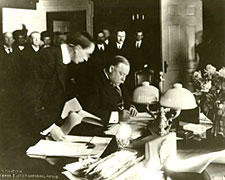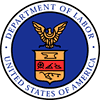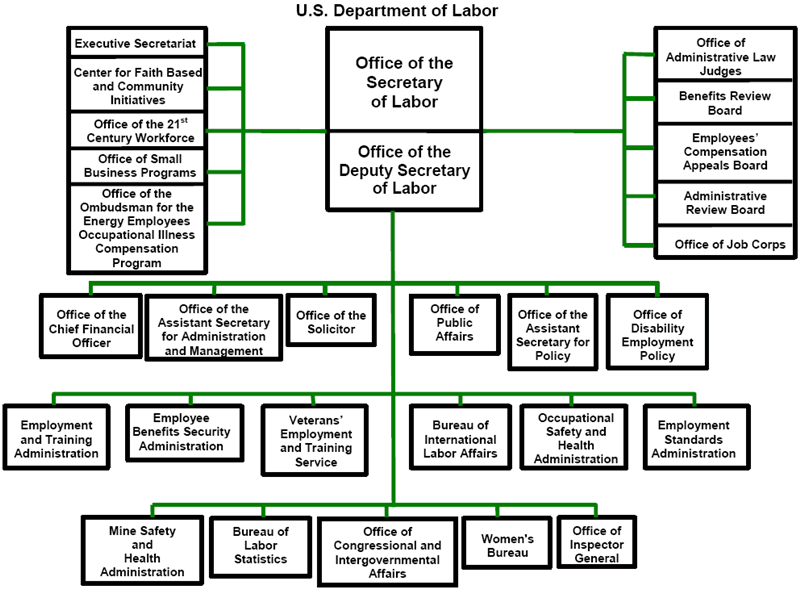|
Mission
The Department of Labor (DOL or the Department) fosters and promotes the welfare of the job seekers, wage earners, and retirees of the United States by improving their working conditions, advancing their opportunities for profitable employment, protecting their retirement and health care benefits, helping employers find and retain workers, strengthening free collective bargaining, and tracking changes in employment, prices, and other national economic measurements.
 |
President William Howard Taft signed the bill establishing the Department of Labor on March 4, 1913, just hours before leaving office. In the words of the act establishing the Department of Labor, its main purpose is "to foster, promote and develop the welfare of working people, to improve their working conditions, and to advance their opportunities for profitable employment." While socio-economic conditions have changed greatly since 1913 and new statutory responsibilities have expanded its scope, the Department’s mission remains unchanged. |
Vision
We will promote the economic well-being of workers and their families; help them share in the American dream through rising wages, pensions, health benefits and expanded economic opportunities; and foster safe and healthful workplaces that are free from discrimination.
 |
The seal of the Department of Labor was approved by President Woodrow Wilson on June 21, 1913. The seal is a gold shield divided horizontally by a red band. The gold color denotes integrity; the red color is for courage and endurance.
On the gold shield above the red band is an anvil and below the band is a plough, both in their natural colors. These represent industry. On the red band are a pulley, a lever, and an inclined plane. They are in silver and represent the three fundamental principles of mechanics and represent humanity’s efforts to understand and harness the forces of nature for productive ends.
The crest is an eagle with outspread wings.
|
Organization and Program Activities
DOL accomplishes its mission through component agencies and offices that administer the various statutes and programs on behalf of the Department. These programs are carried out through a network of regional offices and smaller field, district, and area offices, as well as through grantees and contractors. The largest program agencies, each headed by an Assistant Secretary, Commissioner, or Director, are the Employment and Training Administration (ETA), Employment Standards Administration (ESA), Occupational Safety and Health Administration (OSHA), Mine Safety and Health Administration (MSHA), Veterans’ Employment and Training Service (VETS), Employee Benefits Security Administration (EBSA), Pension Benefit Guaranty Corporation (PBGC)1, and Bureau of Labor Statistics (BLS). The organization chart and the major activity description that follows include the most significant offices of the Department.

Employment and Training
ETA provides high quality job training and education, employment, labor market information, and income maintenance services primarily through State and local workforce investment systems. For example, the Trade Adjustment Assistance Program provides re-employment services such as occupational training, job search and relocation assistance, and income support to workers who have lost their jobs due to increased imports or shifts of production to foreign countries.
VETS helps veterans, reservists, and National Guard members in securing and maintaining employment and the rights and benefits associated with employment.
The Women's Bureau (WB) promotes profitable employment opportunities for women, empowering them by enhancing their skills and improving their working conditions, and providing employers with more alternatives to meet their labor needs.
The Office of Disability Employment Policy (ODEP) seeks to increase employment opportunities for people with disabilities by expanding access to training, education, employment supports, assistive technology, integrated employment, entrepreneurial development, and small-business opportunities.
Unemployment Insurance
ETA's Unemployment Insurance (UI) programs provide unemployment benefits to workers who are unemployed because of a lack of suitable work and meet other eligibility requirements that are established mostly by the States.
Workers' Compensation
ESA's Office of Workers' Compensation Programs (OWCP) provides wage replacement benefits, medical treatment, vocational rehabilitation, and other benefits to Federal and certain other workers who are injured at work or acquire an occupational disease, and/or to other members of their families.
Workplace Safety and Health
OSHA seeks to assure for every working man and woman in the Nation safe and healthful working conditions. OSHA enforces compliance with the regulations and safety and health standards contained in the Occupational Safety and Health Act. Employers subject to the Act have a general duty to provide work and a workplace free from recognized, serious hazards.
MSHA protects the safety and health of miners by assuring compliance with Federal safety and health standards through inspections and investigations and working cooperatively with the mining industry, labor, and States to improve training programs aimed at preventing accidents and occupationally-caused diseases.
ESA protects the welfare and rights of, and generates equal employment opportunity for, American workers by promoting compliance with laws such as the Fair Labor Standards Act, which contains rules concerning the safe employment of young workers.
Health Plan and Retirement Benefit Protections
The Department is responsible for administering and enforcing provisions of the Employee Retirement Income Security Act (ERISA). EBSA enforces ERISA through civil and criminal actions, provides consumer information on benefit plans and compliance assistance to employers and plan service providers and develops regulations encouraging the growth of employment-based benefits.
PBGC, for which the Secretary serves as Chair of the Board of Directors, insures retirement-plan participants' pension benefits and supports a healthy retirement plan system by encouraging the continuation and maintenance of private pension plans, protecting pension benefits in ongoing plans, providing timely payments of benefits in the case of terminated pension plans, and making the maximum use of resources and maintaining premiums and operating costs at the lowest levels consistent with statutory responsibilities.
Labor Statistics
BLS provides key economic statistics to the public, Congress, Federal agencies, State and local governments, businesses, and others, including data on employment, wages, inflation, productivity, and many other topics.
International Policy
The Bureau of International Labor Affairs (ILAB) develops and implements Departmental policy, oversees programs relating to international labor activities, and coordinates Departmental international activities involving other U.S. Government agencies, intergovernmental and non-governmental organizations.
Report Outline
This report, prepared in accordance with the Reports Consolidation Act of 2000, presents the results of the Department's program and financial performance for FY 2007. It is divided into four sections:
- The Secretary's Message is a letter from the chief executive that highlights the Department's achievements for the year and communicates direction and priorities.
- Management's Discussion and Analysis (MD&A) introduces the Department's mission, vision, organization, and activities; summarizes program and financial performance, including Program Assessment Rating Tool reviews and compliance with relevant financial management legislation; addresses major management challenges such as those identified annually by the Office of Inspector General (OIG); and reports on DOL's implementation of the President's Management Agenda.
- The Performance Section presents program results and costs, and includes assessments of progress in achieving the Department's performance goals as presented in the Strategic Plan and Performance Budget.
- The Financial Section demonstrates our commitment to effective stewardship over the funds DOL receives to carry out the mission of the Department. It includes a letter from the Chief Financial Officer, the Independent Auditors' Report (an independent opinion on the Consolidated Financial Statements) and the Annual Financial Statements.
Three Appendices supplement the performance and financial sections by providing additional information on improper payments reduction, a list of acronyms and a list of Web sites featuring labor programs and issues.
 |
Labor Day History
Labor Day, celebrated on the first Monday in September, is a yearly national tribute to the contributions workers have made to the strength, prosperity, and well-being of America. The Central Labor Union of New York City first proposed to celebrate Labor Day “as a general holiday for the laboring classes.” They appointed a committee that planned a street parade to demonstrate the esprit de corps of the trade unions and a festival for workers and their families, and held the first celebration on Tuesday, September 5, 1882, in New York City. Members took unpaid leave and invited other unions to join them in the march. At first, only a handful of marchers assembled and onlookers jeered. Then, shortly before the march started, 200 men and a band from the Jewelers’ Union arrived. As the parade inched forward, more and more groups joined in. By the time they reached the reviewing stands in Union Square, there were around 10,000 marchers. Afterwards, the marchers and their families went to Wendel’s Elm Park for a picnic, speeches, dancing and fireworks.
In 1884, the Central Labor Union went back to their original idea of celebrating Labor Day on the first Monday of September. They urged similar organizations in other cities to follow suit, and by 1885, Labor Day was celebrated in many industrial centers across the country. The first governmental recognition of the holiday came through city ordinances passed in 1885 and 1886. Legislation was first introduced in New York, but first passed in Oregon on February 21, 1887. The same year, four more states — Colorado, Massachusetts, New Jersey, and New York — passed Labor Day legislation. Connecticut, Nebraska, and Pennsylvania did so by the end of the decade. Over the next seven years, 23 other states joined. Finally, a bill making it a national holiday was passed unanimously by both houses of Congress and signed by President Grover Cleveland on June 28, 1894.
|
1PBGC — a Federal corporation created by the Employee Retirement Income Security Act of 1974 – is not included in the DOL organization chart. However, in accordance with the requirements of the Government Performance and Results Act (GPRA), PBGC’s performance reporting is included in this report because PBGC’s performance goals are included in the Department’s performance budget.
|




